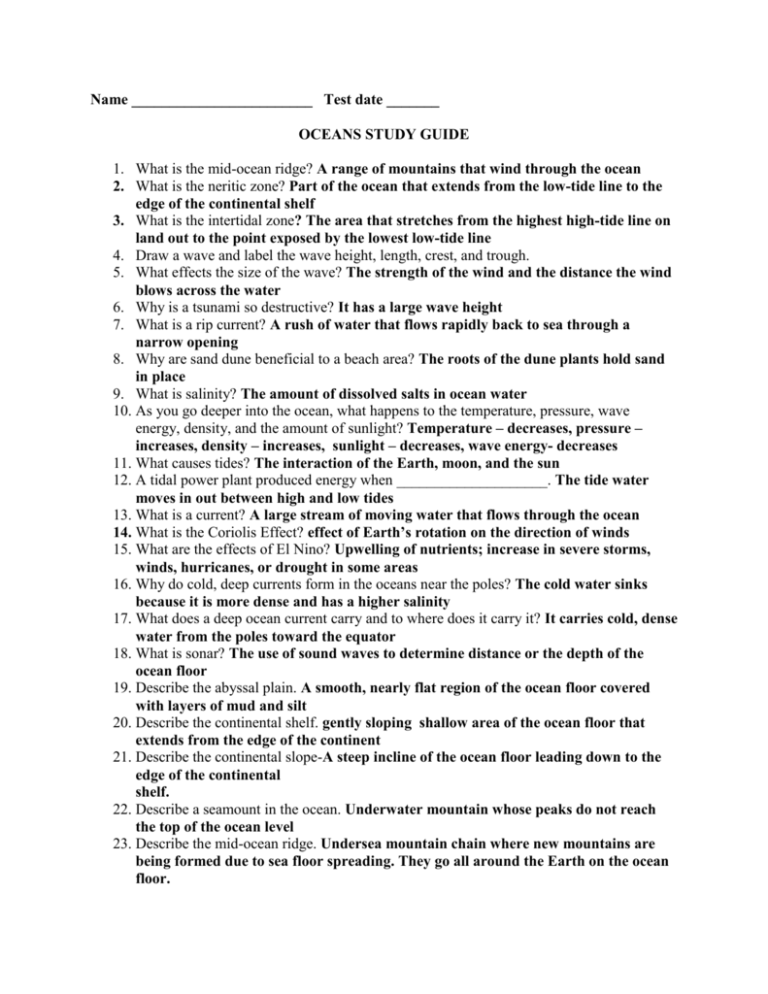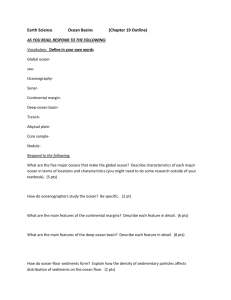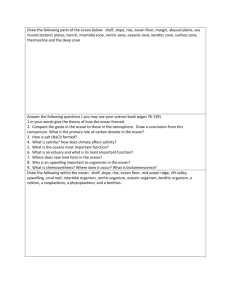oceans study guide
advertisement

Name ________________________ Test date _______ OCEANS STUDY GUIDE 1. What is the mid-ocean ridge? A range of mountains that wind through the ocean 2. What is the neritic zone? Part of the ocean that extends from the low-tide line to the edge of the continental shelf 3. What is the intertidal zone? The area that stretches from the highest high-tide line on land out to the point exposed by the lowest low-tide line 4. Draw a wave and label the wave height, length, crest, and trough. 5. What effects the size of the wave? The strength of the wind and the distance the wind blows across the water 6. Why is a tsunami so destructive? It has a large wave height 7. What is a rip current? A rush of water that flows rapidly back to sea through a narrow opening 8. Why are sand dune beneficial to a beach area? The roots of the dune plants hold sand in place 9. What is salinity? The amount of dissolved salts in ocean water 10. As you go deeper into the ocean, what happens to the temperature, pressure, wave energy, density, and the amount of sunlight? Temperature – decreases, pressure – increases, density – increases, sunlight – decreases, wave energy- decreases 11. What causes tides? The interaction of the Earth, moon, and the sun 12. A tidal power plant produced energy when ____________________. The tide water moves in out between high and low tides 13. What is a current? A large stream of moving water that flows through the ocean 14. What is the Coriolis Effect? effect of Earth’s rotation on the direction of winds 15. What are the effects of El Nino? Upwelling of nutrients; increase in severe storms, winds, hurricanes, or drought in some areas 16. Why do cold, deep currents form in the oceans near the poles? The cold water sinks because it is more dense and has a higher salinity 17. What does a deep ocean current carry and to where does it carry it? It carries cold, dense water from the poles toward the equator 18. What is sonar? The use of sound waves to determine distance or the depth of the ocean floor 19. Describe the abyssal plain. A smooth, nearly flat region of the ocean floor covered with layers of mud and silt 20. Describe the continental shelf. gently sloping shallow area of the ocean floor that extends from the edge of the continent 21. Describe the continental slope-A steep incline of the ocean floor leading down to the edge of the continental shelf. 22. Describe a seamount in the ocean. Underwater mountain whose peaks do not reach the top of the ocean level 23. Describe the mid-ocean ridge. Undersea mountain chain where new mountains are being formed due to sea floor spreading. They go all around the Earth on the ocean floor. 24. What creates waves in the ocean? wind 25. What causes a tsunami? An earthquake on the ocean floor 26. What is a groin and why would you want to build one? A wall of rock or concrete built outward from a beach to help prevent erosion 27. When evaporation occurs, does salinity increase / decrease / say the same? Increases 28. Draw a spring tide 29. Draw a neap tide. 30. What is the Gulf Stream? A large powerful warm surface current in the Atlantic Ocean that affects the climate of land in its path 31. What is an upwelling and what does it bring? Rise of cold, deep ocean currents from the bottom of the ocean up the continental slope that brings organism, minerals, and nutrients 32. What causes the currents to flow in a curved pattern? The Coriolis Effect 33. Is the Canary Current cold or warm? warm 34. How does the North Atlantic Drift affect the climate of northwestern Europe? It makes the climate warmer 35. Will a raft float higher in the ocean or fresh water? WHY? Higher – the ocean water is more dense 36. If you were in a sail boat in the Atlantic Ocean sailing from the western coast of South Africa (and the winds died – OH, NO!), where would the currents push you? Toward the coast of South America Name ________________________ Test date __________________ OCEANS STUDY GUIDE 1. What is the mid-ocean ridge? 2. What is the neritic zone? 3. What is the intertidal zone? 4. Draw a wave and label the wave height, length, crest, and trough. 5. What affects the size of the wave? 6. Why is a tsunami so destructive? 7. What is a rip current? 8. Why are sand dunes beneficial to a beach area? 9. What is salinity? 10. As you go deeper into the ocean, what happens to the temperature, pressure, density, wave energy and the amount of sunlight? 11. What causes tides? 12. A tidal power plant produces energy when ____________________. 13. What is a current? 14. What is the Coriolis Effect? 15. What are the effects of El Nino? 16. Why do cold, deep currents form in the oceans near the poles? 17. What does a deep ocean current carry and to where does it carry it? 18. What is sonar? 19. Describe the abyssal plain. 20. Describe the continental shelf. 21. Describe the continental slope. 22. Describe a seamount in the ocean. 23. Describe the mid-ocean ridge. 24. What creates waves in the ocean? 25. What causes a tsunami? 26. What is a groin and why would you want to build one? 27. When evaporation occurs, does salinity increase / decrease / say the same? 28. Draw a spring tide. 29. Draw a neap tide. 30. What is the Gulf Stream? 31. What is an upwelling and what does it bring? 32. What causes the currents to flow in a curved pattern? 33. Is the Canary Current cold or warm? 34. How does the North Atlantic Drift affect the climate of northwestern Europe? 35. Will a raft float higher in the ocean or fresh water? WHY? 36. If you were in a sail boat in the Atlantic Ocean sailing from the western coast of South Africa (and the winds died – OH, NO!), where would the currents push you?







